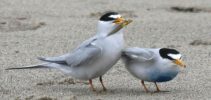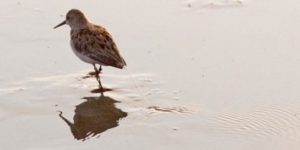Articles
 A Remote Marking Device and Newly Developed Permanent Dyes for Wildlife Research
A Remote Marking Device and Newly Developed Permanent Dyes for Wildlife Research
2017, Wildlife Society Bulletin
Description of a novel, remotely controlled dye machine to rapidly mark stationary animals in predictable locations, such as birds sitting on nests on the ground or mammals at a den or burrow site.
Temporal Analysis of MTDNA Variation Reveals Decreased Genetic Diversity in Least Terns
2015, Ecotoxicology
The Least Tern (Sternula antillarum) has undergone large population declines over the last century as a result of direct and indirect anthropogenic factors. The genetic implications of these declines are unknown.
 Trace elements in pacific Dunlin (Calidris alpina pacifica): Patterns of Accumulation and Concentrations in Kidneys and Feathers
Trace elements in pacific Dunlin (Calidris alpina pacifica): Patterns of Accumulation and Concentrations in Kidneys and Feathers
2011, The Condor
Trace element concentrations were measured in Pacific Dunlin (Calidris alpina pacifica) to identify factors
that influence accumulation and to assess toxicity risks. We report concentrations of cadmium, copper, and zinc in
kidneys as well as copper, lead, mercury, selenium and zinc in feathers.
Subspecific Status and Population Genetic Structure of Least Terns (Sternula Antillarum) Inferred by Mitochondrial DNA Control-Region Sequences and Microsatellite DNA
2010, The Auk
The taxonomic identity of endangered populations of the Least Tern (Sternula antillarum) has long been debated. Their current conservation status provides even more impetus to examine the taxonomic distinctness of these groups. We used rapidly evolving mitochondrial DNA control-region sequences (840 base pairs; n = 188) and microsatellite DNA data (7 loci; n = 417) to examine genetic structure within and among three subspecies that occur within the United States: California Least Tern (S. a. browni), Interior Least Tern (S. a. athalassos), and Eastern Least Tern (S. a. antillarum).
Seabirds as Indicators of the Oceanic Environment
1991, Perspectives on the Marine Environment
Oceanic ecosystems are difficult to study. Even with the most advanced equipment, measurements of fish and invertebrate populations are hard to make because of their temporal and geographic patchiness. Additionally, changes in patters of abiotic factors can affect the entire food web, and these changes often alter both abundance and distribution of important commercial species as well as species on which other members of the good web depend. Two major questions that mangers need to answer are: can these changes be predicted, and what is an indicator measurement of these changes?
 Optimal Foraging and Intraspecific Competition in the Tufted Puffin
Optimal Foraging and Intraspecific Competition in the Tufted Puffin
1991, The Condor
Diets of Tufted Puffin (Fratercula cirrhata) chicks and breeding and nonbreeding adults were compared between two years during the breeding season at Kodiak Island, Alaska. Fish dominated the diet of all groups. Nonbreeders ate more invertebrates than did breeders, and chicks were fed the lowest proportion of invertebrates of any group. Non-breeders consumed more pelagic prey then did breeders, which ate more inshore prey. Chicks were fed the largest prey and prey with highest protein and energy values. These data are consistent with central place foraging and optimal foraging theory.
Influence of Abiotic Factors and Prey Distribution on Diet and Reproductive Success of Three Seabird Species in Alaska
1990, Ornis Scandinavica
Seabirds are suggested as useful indicators of the abundance and distribution of various of their prey species as well as indicators of changes in oceanic conditions. Additionally, it is shown that seabirds with varying foraging methods are affected differently, with respect to breeding success, by changes in prey number and availability.
 Concentrations of Seabirds at Oil-drilling Rigs
Concentrations of Seabirds at Oil-drilling Rigs
1990, The Condor
Over the past decade, several studies have attempted to correlate abundance and distribution of seabirds over the ocean with various abiotic and biotic factors. We made observations in the Bering Sea which suggest the oil-drilling rigs, during stage of “spudding in” (beginning to drill), and during the drilling process, attract large numbers of foraging seabirds.
A Method for Collecting Prey from Tufted Puffin Chicks
1986, The Wilson Bulletin
The food habits of seabird chicks in general are not well known. A commonly used method of discovering what seabirds eat is to collect adults and examine the contents of their stomachs, resulting in the death of dependent chicks. Described here is a non-lethal method for analyzing what prey is collected.
Chapters
 Biology of Marine Birds, Chapter 10, Nelson and Baird
Biology of Marine Birds, Chapter 10, Nelson and Baird
1982, CRC Press
An analysis of seabird communication and displays.
 Black-Legged Kittiwake
Black-Legged Kittiwake
1994, The Birds of North America
Report on this gull with a large northern distribution, published in the Birds of North
America, No. 92, 1994
Reports
 A Multinational Study of Neotropical Migrants, the Western Sandpiper as an Example
A Multinational Study of Neotropical Migrants, the Western Sandpiper as an Example
2009, Department of Defense
Because populations of Neotropical migrant shorebird have been decreasing over the past 20 years, we chose the Western Sandpiper, a ubiquitous and numerous species which co-occurs with a myriad of other shorebird species, to be a model of this migration. Understanding Western Sandpiper’s use of wetlands and its migratory ecology will help to advance understanding of other shorebird species with similar ecology, and will help to address a broad range of problems in the conservation of migratory birds and their North American Pacific coastal habitats.
Department of Defense Legacy Resource Management Program: The Migration of Shorebirds Pamphlet in Spanish, English, and French
2005, Department of Defense
A pamphlet in partnership with the Department of Defense of The Migration of Shorebirds report presented in three languages; Spanish, English, and French. An international study of shorebirds and the effects of predators, diet, and human pressure on their populations.
 The Breeding Biology and Feeding Ecology of Marine Birds in the Gulf of Alaska
The Breeding Biology and Feeding Ecology of Marine Birds in the Gulf of Alaska
1983, Outer Continental Shelf Environmental Assessment Program
This summary of the breeding biology and feeding ecology of marine birds synthesizes work conducted by members of the United States Fish and Wildlife Service (USFWS) or subcontractees to the USFWS over the period 1975-1979. The key species targeted for study were: Northern Fulmar, Leach’s and Fork-tailed Storm-Petrels, Double-crested, Pelagic and Red-faced Cormorants, Glaucous winged and Mew Gulls, Black-legged Kittiwakes, Arctic and Aleutian Terns, Common and Thick-billed Murres, and Horned and Tufted Puffins. The islands or island complexes at which we conducted this research were, in order from west to east: Shumagin, Semidi, Ugaiushak, Kodiak/Sitkalidak, Barren, Chisik, Wooded, Hinchinbrook, Middleton and Forrester.
Marine Bird and Mammal Survey of the Eastern Aleutian Islands, Summers of 1980-81
1982, U.S. Fish and Wildlife Service
Seventy-nine islands in the eastern Aleutian Islands located between Unimak and Samalga Passes were surveyed for breeding seabirds during the summers of 1980 and 1981. Over the two years we surveyed almost 2200 km of shoreline and set up 38 camps, spending time ashore on every island especially at night. We found that 68 of the 79 islands visited contained colonies with at least 1,800,000 breeding seabirds.
